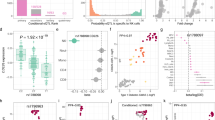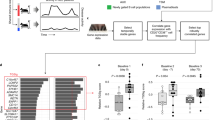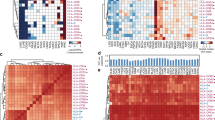Abstract
Multiple follicular lymphoma (FL) susceptibility single-nucleotide polymorphisms in the human leukocyte antigen (HLA) class I and II regions have been identified, including rs6457327, rs3117222, rs2647012, rs10484561, rs9268853 and rs2621416. Here we validated previous expression quantitative trait loci results with real-time reverse transcription quantitative PCR and investigated protein expression in B-lymphoblastoid cell lines and primary dendritic cells using flow cytometry, cell-based enzyme-linked immunosorbent assay and western blotting. We confirmed that FL-protective rs2647012-linked variants, in high linkage disequilibrium with the extended haplotype DRB1*15:01-DQA1*01:02-DQB1*06:02, correlate with increased HLA-DQB1 expression. This association remained significant at the protein level and was reproducible across different cell types. We also found that differences in HLA-DQB1 expression were not related to changes in activation markers or class II, major histocompatibility complex, transactivator expression, suggesting the role of an alternative regulatory mechanism. However, functional analysis using RegulomeDB did not reveal any relevant regulatory candidates. Future studies should focus on the clinical relevance of increased HLA-DQB1 protein expression facilitating tumor cell removal through increased immune surveillance.
This is a preview of subscription content, access via your institution
Access options
Subscribe to this journal
Receive 6 digital issues and online access to articles
$119.00 per year
only $19.83 per issue
Buy this article
- Purchase on Springer Link
- Instant access to full article PDF
Prices may be subject to local taxes which are calculated during checkout

Similar content being viewed by others
References
Cerhan JR . Host genetics in follicular lymphoma. Best Pract Res Clin Haematol 2011; 24: 121–134.
Skibola CF, Bracci PM, Halperin E, Conde L, Craig DW, Agana L et al. Genetic variants at 6p21.33 are associated with susceptibility to follicular lymphoma. Nat Genet 2009; 41: 873–875.
Conde L, Halperin E, Akers NK, Brown KM, Smedby KE, Rothman N et al. Genome-wide association study of follicular lymphoma identifies a risk locus at 6p21.32. Nat Genet 2010; 42: 661–664.
Smedby KE, Foo JN, Skibola CF, Darabi H, Conde L, Hjalgrim H et al. GWAS of follicular lymphoma reveals allelic heterogeneity at 6p21.32 and suggests shared genetic susceptibility with diffuse large B-cell lymphoma. PLoS Genet 2011; 7: e1001378.
Skibola CF, Conde L, Foo JN, Riby J, Humphreys K, Sille FC et al. A meta-analysis of genome-wide association studies of follicular lymphoma. BMC Genomics 2012; 13: 516.
Vijai J, Kirchhoff T, Schrader KA, Brown J, Dutra-Clarke AV, Manschreck C et al. Susceptibility loci associated with specific and shared subtypes of lymphoid malignancies. PLoS Genet 2013; 9: e1003220.
Conde L, Bracci PM, Richardson R, Montgomery SB, Skibola CF . Integrating GWAS and expression data for functional characterization of disease-associated SNPs: an application to follicular lymphoma. Am J Hum Genet 2013; 92: 126–130.
Skibola CF, Akers NK, Conde L, Ladner M, Hawbecker SK, Cohen F et al. Multi-locus HLA class I and II allele and haplotype associations with follicular lymphoma. Tissue Antigens 2012; 79: 279–286.
Chang KC, Huang X, Medeiros LJ, Jones D . Germinal centre-like versus undifferentiated stromal immunophenotypes in follicular lymphoma. J Pathol 2003; 201: 404–412.
Jin MK, Hoster E, Dreyling M, Unterhalt M, Hiddemann W, Klapper W . Follicular dendritic cells in follicular lymphoma and types of non-Hodgkin lymphoma show reduced expression of CD23, CD35 and CD54 but no association with clinical outcome. Histopathology 2011; 58: 586–592.
Briata P, Radka SF, Sartoris S, Lee JS . Alternative splicing of HLA-DQB transcripts and secretion of HLA-DQ beta-chain proteins: allelic polymorphism in splicing and polyadenylylation sites. Proc Natl Acad Sci USA 1989; 86: 1003–1007.
Královicová J, Vorechovsky I . Position-dependent repression and promotion of DQB1 intron 3 splicing by GGGG motifs. J Immunol 2006; 176: 2381–2388.
Kralovicova J, Houngninou-Molango S, Kramer A, Vorechovsky I . Branch site haplotypes that control alternative splicing. Hum Mol Genet 2004; 13: 3189–3202.
Britten AC, Mijovic CH, Barnett AH, Kelly MA . Differential expression of HLA-DQ alleles in peripheral blood mononuclear cells: alleles associated with susceptibility to and protection from autoimmune type 1 diabetes. Int J Immunogenet 2009; 36: 47–57.
Wang H, Wang Q, Pape UJ, Shen B, Huang J, Wu B et al. Systematic investigation of global coordination among mRNA and protein in cellular society. BMC Genomics 2010; 11: 364.
Greenbaum D, Colangelo C, Williams K, Gerstein M . Comparing protein abundance and mRNA expression levels on a genomic scale. Genome Biol 2003; 4: 117.
Van Gool SW, Vandenberghe P, de Boer M, Ceuppens JL . CD80, CD86 and CD40 provide accessory signals in a multiple-step T-cell activation model. Immunol Rev 1996; 153: 47–83.
Krawczyk M, Peyraud N, Rybtsova N, Masternak K, Bucher P, Barras E et al. Long distance control of MHC class II expression by multiple distal enhancers regulated by regulatory factor X complex and CIITA. J Immunol 2004; 173: 6200–6210.
Prod'homme T, Drenou B, De Ruyffelaere C, Barbieri G, Wiszniewski W, Bastard C et al. Defective class II transactivator expression in a B lymphoma cell line. Leukemia 2004; 18: 832–840.
Fairfax BP, Makino S, Radhakrishnan J, Plant K, Leslie S, Dilthey A et al. Genetics of gene expression in primary immune cells identifies cell type-specific master regulators and roles of HLA alleles. Nat Genet 2012; 44: 502–510.
Boyle AP, Hong EL, Hariharan M, Cheng Y, Schaub MA, Kasowski M et al. Annotation of functional variation in personal genomes using RegulomeDB. Genome Res 2012; 22: 1790–1797.
Doran G . The short and the long of UTRs. J RNAi Gene Silencing 2008; 4: 264–265.
Halvorsen M, Martin JS, Broadaway S, Laederach A . Disease-associated mutations that alter the RNA structural ensemble. PLoS Genetics 2010; 6: e1001074.
Alcina A, Abad-Grau Mdel M, Fedetz M, Izquierdo G, Lucas M, Fernandez O et al. Multiple sclerosis risk variant HLA-DRB1*1501 associates with high expression of DRB1 gene in different human populations. PLoS One 2012; 7: e29819.
Akers NK, Curry JD, Conde L, Bracci PM, Smith MT, Skibola CF . Association of HLA-DQB1 alleles with risk of follicular lymphoma. Leuk Lymphoma 2011; 52: 53–58.
Foo JN, Smedby KE, Akers NK, Berglund M, Irwan ID, Jia X et al. Coding variants at hexa-allelic amino acid 13 of HLA-DRB1 explain independent SNP associations with follicular lymphoma risk. Am J Hum Genet 2013; 93: 167–172.
Skibola CF, Nieters A, Bracci PM, Curry JD, Agana L, Skibola DR et al. A functional TNFRSF5 gene variant is associated with risk of lymphoma. Blood 2008; 111: 4348–4354.
Grubbs FE . Procedures for detecting outlying observations in samples. Technometrics 1969; 11: 1–21.
Acknowledgements
This work was supported by National Institutes of Health grants CA154643 and CA104682 (CFS).
Author contributions
CFS obtained financial support for the study; FCMS, LC and CFS designed the study; FCMS, JZ, NKA, SS and JM, performed experiments; FCMS and LC analyzed data; FCMS, LC and CFS wrote the manuscript; All authors contributed to the final manuscript and approved its content.
Author information
Authors and Affiliations
Corresponding author
Ethics declarations
Competing interests
The authors declare no conflict of interest.
Additional information
Supplementary Information accompanies this paper on Genes and Immunity website
Supplementary information
Rights and permissions
About this article
Cite this article
Sillé, F., Conde, L., Zhang, J. et al. Follicular lymphoma-protective HLA class II variants correlate with increased HLA-DQB1 protein expression. Genes Immun 15, 133–136 (2014). https://doi.org/10.1038/gene.2013.64
Received:
Revised:
Accepted:
Published:
Issue Date:
DOI: https://doi.org/10.1038/gene.2013.64



